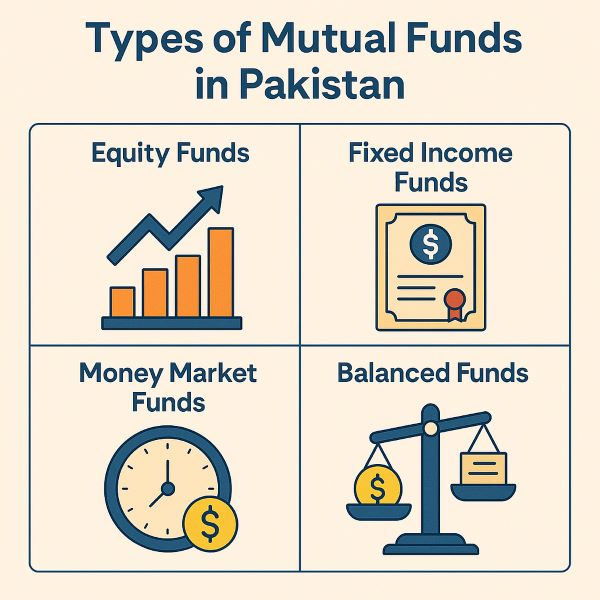Understanding Mutual Funds in Pakistan & Its Mechanics
The Easy Guide For Your Understanding

Mutual Funds in Pakistan provide a wide variety of categories. It has the potential for good gains, but at the same time probability of losses as well.
Ride may be exciting, but it has to be done with fastened seat belts and helmets.
As the name says, 'Mutual', that means Mutual funds are collective investment schemes that people pool money together and give it to a professional institution like banks and other financial companies to create professionally managed, diversified portfolios of securities such as stocks, bonds, and money market instruments.
This structure makes sophisticated investing accessible, liquid, and affordable for individual investors.
The industry in Pakistan is regulated by the Securities & Exchange Commission of Pakistan (SECP), with MUFAP serving as the official trade body.
Funds are operated by Asset Management Companies (AMCs) and the assets are held in custody by a Trustee, ensuring a robust governance framework.
Salient Points of Mutual Funds in Pakistan
Some key salient points include:
- Structure and Types: Funds are primarily classified as open-ended (units bought/redeemed on demand at Net Asset Value) or closed-ended (fixed shares traded on a stock exchange). The SECP further categorizes funds by investment strategy, including Equity, Income, Balanced, Shariah Compliant, and Money Market schemes, catering to varied risk appetites and investment horizons.
- Investor Benefits: The primary advantages are professional management, risk reduction through diversification, high liquidity allowing conversion to cash on any working day, and accessibility for small investors.
- Taxation Incentives: The framework offers significant tax benefits. Individual investors can claim a tax credit under Section 62 of the Income Tax Ordinance, 2001. Furthermore, Capital Gains Tax (CGT) is structured to reward long-term investment, with a 0% rate for securities held for 24 months or more.
- Regulatory Oversight: The SECP provides stringent oversight through licensing, continuous monitoring via mandatory reporting, and on-site inspections of AMCs, ensuring investor protection and market integrity.
Framework for The Mutual Funds in Pakistan
The core mechanism behind the mutual funds in Pakistan involves investors entrusting their money to an Asset Management Company (AMC).
The AMC's professional fund managers then invest this pooled capital into securities like stocks, bonds, and money market instruments.
The returns generated from these investments, including income and capital appreciation, are then distributed back to the investors (unit holders) in proportion to their ownership.
Regulatory and Operational Structure
The good part is that the Mutual Fund industry in Pakistan operates under a well-defined regulatory structure involving several key entities:
- Mutual Funds Association of Pakistan (MUFAP): The government-licensed trade body for the mutual fund industry. All AMCs and Investment Advisory services licensed by the SECP are required to be members.
- Securities & Exchange Commission of Pakistan (SECP): The primary regulator of the mutual funds industry. The SECP is responsible for issuing licenses for Collective Investment Schemes (CIS), approving fund establishments, and conducting continuous monitoring through regular reports and on-site inspections of AMCs.
- Asset Management Companies (AMCs): Public limited companies registered under the Companies Ordinance, 1984, that operate and manage mutual funds. An AMC launches a new fund by establishing a Trust Deed.
- Trustee: A custodian of the fund's assets, responsible for ensuring that the Fund Manager's investment decisions align with the fund's stated investment policy. Under Pakistani law, banks and central depository companies approved by the SECP can act as trustees. The Central Depository Company of Pakistan (CDC) currently serves as the trustee for most funds in the industry.
The establishment of a Mutual Fund requires a Trust Deed entered into between the AMC and the Trustee, which must receive due approval from the SECP under the Non-Banking Finance Companies (Establishment and Regulation) Rules, 2003.
Types and Categories of Mutual Funds In Pakistan

Mutual funds in Pakistan are classified based on their structure and their investment objectives as categorized by the SECP.
Structural Classification
- Open-Ended Mutual Funds (Unit Trusts): These funds continually create new units for investors to buy or redeem existing units on demand. Unit holders can buy or sell units on a continuous basis directly from the Management Company at the prevailing Net Asset Value (NAV).
- Closed-Ended Mutual Funds: These funds issue a fixed number of shares through an Initial Public Offering (IPO). After issuance, these shares are traded on the secondary market (Stock Exchange) at market rates, similar to the shares of a public company.
SECP Investment Categories
The SECP has categorized mutual fund schemes to reflect their investment strategies and objectives:
Equity Scheme invests primarily in stocks (equities) with the objective of long-term growth through capital appreciation.
Balanced Scheme invests in a mix of stocks and debt instruments to provide a balance of growth and income.
Asset Allocation Fund diversifies assets across multiple security types and investment styles available in the market.
Fund of Fund Scheme invests in a portfolio of other mutual funds (equity, balanced, fixed income, etc.).
Shariah Compliant (Islamic) Scheme invests only in Shariah-compliant securities (shares, Sukuk, Ijara sukuks) as approved by a Shariah Advisor.
Capital Protected Scheme guarantees the return of the original investment amount, plus any potential capital gains, at the end of a specific contractual term.
Index Tracker Scheme aims to mirror the performance of a market index, such as the KSE 100, by holding securities in the same proportion as the index.
Money Market Scheme is one of the safest fund types, investing in short-term debt instruments like Treasury bills and bank deposits.
Income Scheme focuses on providing a steady stream of income by investing in short and long-term debt instruments like TFCs and government securities.
Aggressive Fixed Income Scheme seeks to generate high returns by investing in fixed-income securities, including those of medium to lower quality.
Commodity Scheme enables investment in commodities like gold by investing at least 70% of assets in commodity futures contracts.
Key Investor Benefits for Investing in Mutual Funds in Pakistan

Investing in mutual funds in Pakistan offers several distinct advantages, particularly for individual investors.
- Accessibility: Mutual fund units are simple and easy to purchase.
- Liquidity: Unit holders can convert their investments into cash on any working day by redeeming their units with the fund itself, which then pays out the current value promptly.
- Diversification: By pooling money, a mutual fund invests in a wide array of securities, which spreads and reduces investment risk. Achieving a similar level of diversification would be difficult for an average investor with limited capital.
- Professional Management: AMCs employ expert fund managers who evaluate market opportunities and make informed investment decisions, a task that can be complex for individuals or non-financial corporate entities.
Investment Mechanics and Valuation
Mostly, Mutual Fund performance rests on the main KPI, i.e., NAV (Net Asset Value - Daily Basis)
- Calculating Unit Price (Net Asset Value - NAV)
The price per unit of a mutual fund is represented by its Net Asset Value (NAV). It is calculated daily using the following formula:
- NAV = (Current Market Value of all Assets – Liabilities) / Total Number of Units Outstanding
The sale price of a unit is determined by adding a sales load to the NAV. If there is no sales load, the NAV serves as both the sale and redemption price.
Investment and Disinvestment Process in Mutual Funds in Pakistan
How to Invest in Mutual Funds in Pakistan
- Individuals: Must provide a copy of their CNIC, a completed Application/Account Opening Form, a Purchase of Units Form, and optional Zakat Affidavit, along with KYC and FATCA forms. Investment is made via a cheque in favor of the fund's Trustee.
- Corporate/Institutional Investors: Must provide foundational documents (e.g., Memorandum and Articles of Association, Trust Deed), a Board/Trustee resolution authorizing the investment, relevant forms, a Power of Attorney for the authorized officer, NTN, and a cheque.
How to Disinvest (Redeem): An investor can redeem units by submitting a Redemption Form at a designated sales point of the AMC. The redemption payment is processed within a maximum of six working days and paid via a cross-cheque or bank transfer.
Dividend Payments
Dividends can be paid out in cash on a monthly, quarterly, or annual basis, depending on the fund. Investors also have the option to inform the AMC to reinvest the dividend amount, in which case new units are issued instead of a cash payment.
Taxation Framework for Mutual Funds in Pakistan

The tax regime for mutual funds in Pakistan includes incentives for individual investors and specific tax rates for dividend income and capital gains.
NOTE: These can change from time to time in accordance with government policy. You must check with your Mutual Fund Operator for the updated policies.
However, some taxation information is provided below:
Tax Credit for Individual Investors (Section 62)
Under Section 62 of the Income Tax Ordinance, 2001, a resident individual taxpayer is entitled to a tax credit on investments in new shares of a listed public company, which includes units of mutual funds.
- Eligibility: The tax credit is available on the lower of:
- The actual cost of the investment.
- 20% of the individual's taxable income for the year.
- Rs. 1 million.
- Holding Period: The investment must be held for at least 24 months from the date of acquisition. If disposed of within this period, the tax credit availed must be paid back.
Tax Credit Examples for Salaried Individuals
Annual Taxable Income (Upper Limits): PKR 750,000
- Average Tax Rate: 5%
- Gross Tax Payable: PKR 35,000
- Investment for Tax Credit (20% of Income): PKR 150,000
- Tax Credit Available Tax Saving (% of Investment): PKR 7000
- Tax Savings (% of investment): 4.7%
Annual Taxable Income (Upper Limits): PKR 1,500,000
- Average Tax Rate: 10%
- Gross Tax Payable: PKR 147,500
- Investment for Tax Credit (20% of Income): PKR 300,000
- Tax Credit Available Tax Saving (% of Investment):PKR 29,500
- Tax Savings (% of investment): 9.8%
Annual Taxable Income (Upper Limits): PKR 2,500,000
- Average Tax Rate: 14%
- Gross Tax Payable: PKR 347,500
- Investment for Tax Credit (20% of Income): PKR 500,000
- Tax Credit Available Tax Saving (% of Investment): PKR 69,500
- Tax Savings (% of investment): 13.9%
Annual Taxable Income (Upper Limits): PKR 4,000,000
- Average Tax Rate: 18%
- Gross Tax Payable: PKR 722,500
- Investment for Tax Credit (20% of Income): PKR 800,000
- Tax Credit Available Tax Saving (% of Investment): PKR 144,500
- Tax Savings (% of investment): 18.1%
Annual Taxable Income (Upper Limits): PKR 6,000,000
- Average Tax Rate: 22%
- Gross Tax Payable: PKR 1,322,500
- Investment for Tax Credit (20% of Income): PKR 1,000,000
- Tax Credit Available Tax Saving (% of Investment): PKR 220,417
- Tax Savings (% of investment): 22%
Note: Maximum investment eligible for tax credit is restricted to Rs. 1 million.
Tax Credit Examples for Self-Employed Individuals:
Annual Taxable Income (Upper Limits): PKR 750,000
- Average Tax Rate Gross Tax:2%
- Gross Tax Payable: PKR 17,500
- Payable Investment for Tax Credit (20% of Income): PKR 150,000
- Tax Credit Available: PKR 3500
- Tax Saving (% of Investment): 2.3%
Annual Taxable Income (Upper Limits): PKR 1,500,000
- Average Tax Rate Gross Tax:6%
- Gross Tax Payable: PKR 95,000
- Payable Investment for Tax Credit (20% of Income): PKR 300,000
- Tax Credit Available: PKR 19,000
- Tax Saving (% of Investment): 6.3%
Annual Taxable Income (Upper Limits): PKR 2,500,000
- Average Tax Rate Gross Tax:11%
- Gross Tax Payable: PKR 262,500
- Payable Investment for Tax Credit (20% of Income): PKR 500,000
- Tax Credit Available: PKR 52,500
- Tax Saving (% of Investment): 10.5%
Annual Taxable Income (Upper Limits): PKR 4,000,000
- Average Tax Rate Gross Tax:15%
- Gross Tax Payable: PKR 600,000
- Payable Investment for Tax Credit (20% of Income): PKR 800,000
- Tax Credit Available: PKR 120,000
- Tax Saving (% of Investment): 15%
Annual Taxable Income (Upper Limits): PKR 7,000,000
- Average Tax Rate Gross Tax:20%
- Gross Tax Payable: PKR 1,425,000
- Payable Investment for Tax Credit (20% of Income): PKR 1,000,000
- Tax Credit Available: PKR 203,571
- Tax Saving (% of Investment): 20.4%
Note: Maximum investment eligible for tax credit is restricted to Rs. 1 million.
Withholding Tax on Dividend Income
Fund Type: Stock Fund
- Recipient: All recipients (if dividend receipts < capital gains)
- Tax Rate: 12.5%
Fund Type: All Other Mutual Funds
- Recipient: Banks and Companies
- Tax Rate: 25%
Fund Type: All Other Mutual Funds
- Recipient: Individuals and other unit holders
- Tax Rate: 10% for filers, 15% for non-filers
Capital Gains Tax (CGT)
Mutual funds are required to withhold Capital Gains Tax based on the holding period of the security.
- Holding Period Less than twelve months: 12.5%
- Holding Period Twelve months to less than twenty-four months: 10%
- Holding Period Twenty-four months or more: 0%
Wrap up On Mutual Funds in Pakistan

Mutual Funds in Pakistan offer good investment schemes, but it has its own risks and rewards.
It is always advised that one should invest cautiously and check your own risk appetite.
If you don't have the internal capacity to incur losses, then you should choose the capital guaranteed income funds.
The difference between risk and reward is the return rate.
When you choose the capital guaranteed funds, then you will almost get the normal bank savings rates, which may range from 5-10%
On the other hand, if you do have an appetite to take some risks, then you can choose the fund that invests in shares and stocks.
In good times in stock markets (equity market), you can get about 20-40% annual return on your money. But you may also lose the same amount 20-40% of your money, in bad economic times and during the market crashes.
Overall, Mutual Funds in Pakistan and globally are professionally managed funds by big-league companies. The Security of money and trading is very much regulated. However, the promise of returns may vary depending on the type of Fund selection.
You can also learn more about mutual funds in Pakistan here

STAFF WRITER
IdeasBeat is an emerging eMagazine and a Multimedia Publishing House where we hunt for diverse ideas and stories from around the world. We share easy-to-digest articles and curated content from selected sources globally.
Risk Disclaimer
All investments in mutual funds are explicitly subject to market risks. The Net Asset Value (NAV) of units can fluctuate, either rising or falling, based on prevailing market conditions. Past performance is not a reliable indicator of future results. Investors are strongly advised to read the fund's Offering Document carefully, paying close attention to the investment policies, risk disclosures, and warning statements before making an investment decision.